Protecting Outdoor TVs and Digital Signage from Cold Temperatures
Posted by The TV Shield on 28th Dec 2023
Protecting outdoor TVs and digital signage from cold temperatures is crucial to ensure their proper functioning and longevity. Cold temperatures can cause damage to electronic components, such as cracking of the screen or malfunctioning of internal parts. Additionally, extreme cold temperatures can also make it difficult for customers to view and read the information displayed on the screens. To prevent this, it is important to use outdoor digital signage enclosures and TV protection solutions that are specifically designed to withstand cold temperatures. These solutions often feature heating and insulation systems to keep the equipment at optimal operating temperatures, while also protecting it from the elements and other environmental hazards.
Table of Contents:
Understanding the Risks of Cold Temperatures on Outdoor TVs and Digital Signage
The Importance of Proper Insulation for Outdoor TVs and Digital Signage
Types of Materials Used for Cold Weather Protection of Outdoor TVs and Digital Signage
Heating Solutions for Outdoor TVs and Digital Signage
Protecting Your Outdoor TVs and Digital Signage with The TV Shield
Understanding the impact of cold weather on outdoor electronics is essential for effective protection. This includes knowing how temperature fluctuations, frost, and icy conditions can affect screen visibility and internal components.

Understanding the Risks of Cold Temperatures on Outdoor TVs and Digital Signage
Understanding the risks of cold temperatures on outdoor TVs and digital signage is important to ensure their proper functioning and longevity. Cold temperatures can cause a number of problems for electronic equipment, some of which include:
Condensation
Cold temperatures can cause condensation to form inside the equipment, which can lead to short-circuiting and damage to internal components.
Cracking
Extreme cold temperatures can cause the plastic and glass components of the equipment to crack, which can lead to permanent damage and the need for costly repairs.
Reduced Performance
Cold temperatures can cause the electronics inside the equipment to function less efficiently, which can lead to reduced performance and a shorter lifespan.
Viewing Experience
Extreme cold temperatures can make it uncomfortable for customers to view and read the information displayed on the screens, which can negatively impact their experience.
Power Consumption
Cold temperatures can cause a significant increase in power consumption, which can lead to additional costs for the company.
When considering protection against cold temperatures, it's vital to assess all potential risks. This includes the dangers of frost build-up, internal component damage, and reduced battery life in colder climates.To prevent these problems, it is important to use outdoor digital signage enclosures and TV protection solutions that are specifically designed to withstand cold temperatures.
The Importance of Proper Insulation for Outdoor TVs and Digital Signage
Insulation helps to keep the temperature inside the enclosure stable, preventing condensation and making sure that the equipment stays at a safe operating temperature. A well-insulated enclosure also helps to reduce power consumption, as it keeps the heating system from having to work as hard to maintain a comfortable temperature. There are different types of insulation materials and methods to choose from depending on the specific requirements of climate control for your outdoor TV.

Proper insulation is a key component of outdoor digital signage and TV protection solutions, as it helps to ensure the longevity and proper functioning of the equipment while also reducing power consumption and protecting it from environmental hazards.
Types of Materials Used for Cold Weather Protection of Outdoor TVs and Digital Signage
Let’s go through some of the materials best suited for outdoor TV enclosures and digital signage.
Metal
One of the best things about a metal outdoor TV cabinet is that it comes in many different sizes. For bigger screens, metal is usually the best choice. It's strong and lasts a long time. Metal cabinets, on the other hand, tend to be heavier because they are so strong.
Polymer
Compared to metal enclosures, outdoor polymer is less expensive. They are light and easy to put up. They are also easy to clean and care for. HMWPE is the best polymer for a TV enclosure that will be placed outside. It is made of the same material that slides on playgrounds are made of, and it can last for more than 20 years. It is stronger than other outdoor plastics that are used in some digital displays and TV cabinets.
Wood
Even after being painted and sealed, moisture can damage the wood. It won't look brand new for long, and it could put your TV at risk.
In the context of safeguarding outdoor TVs from harsh winter conditions outdoors, effective insulation emerges as a crucial factor. It's not just about keeping the cold out; it's about ensuring that the delicate internal workings of your electronics remain at an optimal operating temperature. This is where the choice of insulation materials and methods plays a pivotal role, tailored to various environmental conditions.
Common Mistakes to Avoid When Using Materials for Cold Weather Protection of Outdoor TVs and Digital Signage
When using materials for cold weather protection of outdoor TVs and digital signage, it is important to avoid common mistakes such as not properly sealing the enclosure. This can lead to condensation and moisture buildup inside the enclosure, which can damage the TV or digital signage.
Not using proper insulation
Another mistake to avoid is not using the appropriate insulation for the specific climate. Using insulation that is not suitable for the temperature range can lead to overheating or freezing of the TV or digital signage.
Proper ventilation
Additionally, it is important to ensure that the enclosure has proper ventilation to prevent overheating and to maintain a consistent temperature inside the enclosure.
UV protection
Lastly, UV-protected enclosure materials help prevent sun damage or overheating.
Heating Solutions for Outdoor TVs and Digital Signage
In colder climates, selecting the right heating solutions is not just a luxury, but a necessity for the functionality of outdoor TVs and digital signage. This section of the blog delves into the variety of heating options available and evaluates their effectiveness across different temperature ranges.
Electric heaters
One popular solution is the use of electric heaters, which can be placed near a TV setup to maintain a consistent temperature in the area. These heaters can be controlled through a thermostat to automatically turn on and off as needed.
Heating solution within TV enclosure
Another solution is the use of a heating system built into the enclosure itself, such as a heating element or a heat exchanger. This type of system can be powered by electricity or by an alternative power source such as solar or propane. In addition, some enclosures are designed with built-in insulation to help retain heat.
It is important to note that, whichever heating solution is used, it is important to ensure that the enclosure has proper ventilation to prevent overheating and to maintain a consistent temperature inside the enclosure. Additionally, it is also important to use a UV-protected enclosure or screen to prevent damage to the TV or digital signage due to exposure to sunlight.
Overall, it is important to choose the right heating solution that fits the specific needs of the outdoor TV or digital signage, as well as the climate conditions and power supply availability.
Protecting Your Outdoor TVs and Digital Signage with The TV Shield
Now that you have a better understanding of how to protect your outdoor TV and digital signage from cold temperatures, be sure to explore our line of weatherproof TV enclosures today and enjoy the experience!
FAQs
What are the main risks of cold temperatures to outdoor TVs and digital signage?
Cold temperatures can lead to condensation, cracking of plastic and glass components, reduced electronic performance, poor viewing experience, and increased power consumption.
How does proper insulation benefit outdoor TVs and digital signage in cold weather?
Proper insulation maintains a stable temperature inside the enclosure, preventing condensation and keeping the equipment at a safe operating temperature. It also helps to reduce power consumption by reducing the need for additional heating.
What materials are best suited for protecting outdoor TVs and digital signage from cold weather?
Metal, due to its durability and strength, is suitable for larger screens. Polymer, particularly HMWPE, is less expensive, easy to maintain, and long-lasting. Wood is generally not recommended due to its susceptibility to moisture damage.
What are common mistakes to avoid when protecting these devices from cold weather?
Common mistakes include not properly sealing the enclosure, using inappropriate insulation for the climate, lacking proper ventilation in the enclosure, and failing to use UV-protected materials to prevent sun damage.
What types of heating solutions are available for outdoor TVs and digital signage in cold climates?
Popular heating solutions are built-in heating systems within the TV enclosure, such as heating elements or heat exchangers. Proper ventilation is crucial regardless of the heating solution to prevent overheating.

